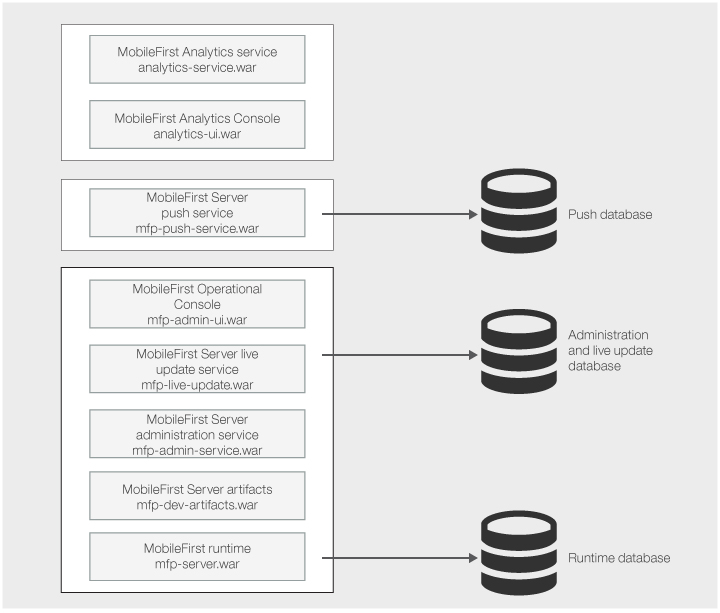For up-to-date product documentation, see the IBM MobileFirst Foundation Developer Center.
MobileFirst Server overview
The administration and deployment operations of the MobileFirst artifacts are done through MobileFirst Operations Console, or the REST API of the MobileFirst Server administration service. The operations can also be done by using some command line tools that wrap this API, such as mfpdev or mfpadm. The authorized users of MobileFirst Server can modify the server-side configuration of mobile applications, upload, or configure server-side code (the adapters), upload new web resources for Cordova mobile apps, run application management operations, and more.
MobileFirst Server offers extra layers of security, in addition to the security layers of the network infrastructure or the application server. The security features include the control of application authenticity and the access control to the server-side resources and the adapters. These security configurations can also be done by the authorized users of MobileFirst Operations Console and the administration service. You determine the authorization of the MobileFirst administrators by mapping them to security roles as described in Configure user authentication for MobileFirst Server administration.
A simplified version of MobileFirst Server that is preconfigured and does not need software prerequisite such as database or an application server is available for developers. See Set up the MobileFirst Development Server .
For production purpose, we can use an installation of MobileFirst Server on-premises or deploy MobileFirst Server to the cloud. See Deploy MobileFirst Server to the cloud.
MobileFirst Server components

MobileFirst Server is composed of several components.
- Core components of MobileFirst Server
- MobileFirst Operations Console, the MobileFirst Server administration service, the MobileFirst Server live update service, the MobileFirst Server artifacts, and the MobileFirst runtime are the minimum set of the components to install. The runtime provides the MobileFirst services to the mobile apps that run on the mobile devices. The administration service provides the configuration and administration capabilities. We use the service via MobileFirst Operations Console, the live update service REST API, or command line tools such as mfpadm or mfpdev. The live update service manages configuration data and is used by the administration service. These components require a database. The database table name for each component does not have any intersection. As such, we can use the same database or even the same schema to store all the tables of these components. For more information, see Set up databases. It is possible to install more than one instance of the runtime. In this case, each instance needs its own database. The artifacts component provides resources for MobileFirst Operations Console. It does not requires a database.
- Optional components of MobileFirst Server
- The MobileFirst Server push service provides push notification capabilities. It must be installed to provide these capabilities of the mobile apps use the MobileFirst Push features (Push notification). From the perspective of mobile apps, the URL of the push service is the same as the URL as the runtime, except that its context root is /imfpush. If we plan to install the push service on a different server or cluster than the runtime, you need to configure the routing rules of your HTTP server. The configuration is to ensure that the requests to the push service and the runtime are properly routed. The push service requires a database. The tables of the push service have no intersection with the tables of the runtime, the administration service, and the live update service. Thus, it can also be installed in the same database or schema. The MobileFirst Analytics service and MobileFirst Analytics Console provide monitoring and analytics information about the mobile apps usage. Mobile apps can provide more insight by using the Logger SDK. The MobileFirst Analytics service does not need a database. It stores its data locally on disk by using Elasticsearch. The data is structured in shards that can be replicated between the members of a cluster of the Analytics service.
- The Server Configuration Tool - a graphical wizard
- Ant tasks through the command line tools
- Manual installation
- A getting started tutorial that guides you through a complete installation of MobileFirst Server farm on WebSphere® Application Server Liberty profile. The tutorial is based on a simple scenario for us to try out the installation either in graphical mode or in command line mode.
- A detailed section (Install MobileFirst Server for a production environment) that contains details about the installation prerequisites, database setup, server topologies, deployment of the components to the application server, and server configuration.
For more information about the network flows and the topology constraints for these components, see Topologies and network flows.
Installation process
The installation of MobileFirst Server on-premises can be done by using the following ways:
In the next sections, more information about the installation of MobileFirst Server on-premises is provided. We can find:
Parent topic: Install IBM MobileFirst Platform Server